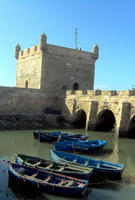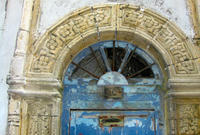You are in: Africa -> Morocco -> Medina of Essaouira ... , and traditional search or Image Gallery will yield results of this site only
Medina of Essaouira (formerly Mogador)
| Site number: | 753 |
|
| Type of site: | Cultural | |
| Date: | 18th-century | |
| Date of Inscription: | 2001 | |
| Location: | Africa, Morocco, Tensift Region, Province of Essaouira | |
Up to 75 images are shown here. Click on each for more details or on Image Gallery for more images.
| Description: | Essaouira was built using the principles of contemporary European military architecture within a North African context; it is an incomparable example of a late-18th-century fortified town. From the time of its foundation the town has been a foremost international trading seaport, connecting Morocco and its Saharan vicinity with Europe as well as the rest of the world. --WHMNet paraphrase from the description at WHC Site, where additional information is available. | |
| Essaouira (Arabic: الصويرة, eṣ-ṣauīrah; formerly known as Mogador, its old Portuguese name) is a city and tourist resort in Morocco, on the Atlantic coast. Archeological research shows that Essaouira has been occupied since prehistorical times. The bay in front of Essaouira is almost closed by the large island of Mogador, making it a relatively peaceful harbour protected against the strong winds of the area. Essaouira has long been considered as one of the best anchorages of the Moroccan coast. During the 5th century BC, she was visited by the Carthaginian navigator Hanno, who established a trading post there. Around the end of the 1st century BC, Juba II established a Tyrian purple factory, processing the murex and purpura shells found in the rocks around Essaouira. This was used to dye the purple strip in Imperial Roman Senatorial togas. During the Middle Ages, a muslim saint named Sidi Mogdoul was buried in Essaouira and gave his name to the locality, which was later transcribed as "Mogador" by the Portuguese. In 1506, the king of Portugal ordered a fortress to be built there, named "Castelo Real de Mogador". The fortress fell to the local resistance of the Regraga fraternity four years later. During the 16th century, various powers including Spain, England, the Netherlands and France tried in vain to conquer the locality. Essaouira remained a small haven for the export of sugar molasses and the anchoring of pirates. --Wikipedia. Text is available under the Creative Commons Attribution-ShareAlike License. | ||
| Source: | http://whc.unesco.org/en/list/753 | |
| Reference: | 1. UNESCO World Heritage Center, Site Page. | |










